Recent high profile news reports, such NBC’s “Paradise Lost: The weight of gold,” are bringing fresh attention to the problem of mercury pollution and deforestation. Our latest story from the field shows the progress we are making in researching and implementing solutions in the Amazon rainforest. This post is by Caroline Baylor, Pure Earth’s Program Associate for Latin America, and France Cabanillas, with support from Sofia López).
—
Since 2019, Pure Earth has worked with AMATAF, an association of artisanal and small-scale gold miners in Madre de Dios, Peru, to counter worsening conditions in the rainforest due to destructive gold mining practices. With the help of miners, Pure Earth experts and partners have been able to carry out innovative research on the conditions of mined-out Amazonian land, and design methods that encourage life on damaged land. The miners are doing their part to ensure the sustainability of reforestation efforts by learning how to make and apply soil amendments to enrich nutrient-poor soil, and providing continued care for the saplings they have planted.
Led by AMATAF president Vilma Contreras, the miners have been rock steady in their eagerness to improve their mining practices and learn to produce gold without mercury, and to learn how to restore and reforest land damaged by mining, seeing it as a way for them to fulfill their obligation to the rainforest.
“One of our objectives is to sell gold mined without mercury to businesses and reforesting areas compromised by mining activity… because the environment is everyone’s responsibility,” says Contreras.
New Study Shows How Reforestation Slows Mercury Dispersal
Reforestation has important implications for mercury contamination and dispersal patterns, as shown in In a new Pure Earth study done to estimate the effects of different deforestation and reforestation scenarios in the area where AMATAF calls home.
Pure Earth researchers found that further deforestation could lead to the displacement of up to 20.16 mg of mercury per hectare into the watershed annually, whereas further reforestation could prevent up to 15.36 mg of mercury per hectare from reaching the watershed annually. The study, which was conducted and written by Dr. Francisco Román, Pure Earth’s own France Cabanillas and Charlie Espinosa, and local hydrologist Edwing Arapa, highlights the importance of the Amazon forest in capturing and storing mercury that would otherwise make its way into the water cycle, where it could wind up in fish, then humans.
Studies have found high mercury levels in people who consume fish from Amazonian rivers. These populations are often indigenous and depend upon fish as an essential part of their nutrition base.
The importance of decreasing mercury use, avoiding deforestation, and encouraging reforestation cannot be understated.
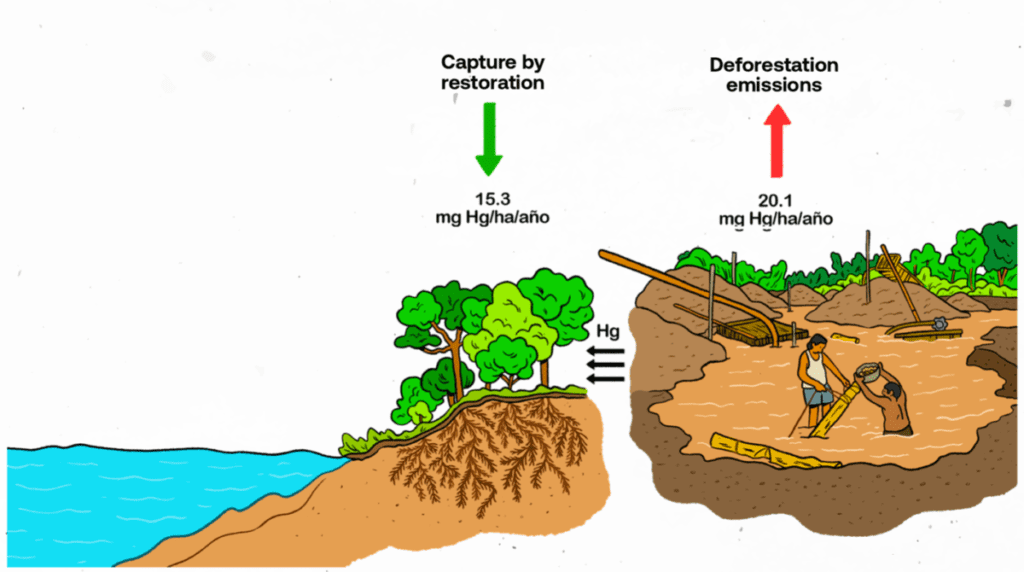
Rainforest Reforestation: More Than Just Planting Trees
Since February 2020, miners have worked with Pure Earth to plant 5,000 trees of varying species in five hectares split between two of AMATAF’s mining concessions, Rosita II and Linda II. Miners, including Linda II concessionaire Hugo Quispe, were inspired by the reforestation trainings and initiated a miner-led effort to reforest an additional hectare of land.
“That is my goal: to recover all the green areas. We want to perform mining well and recover the Amazon,” says Quispe.
Careful measurements of the trees have been made over the past few years to track their progress. In general, the two-year survival rate, measured in June 2022, of over 70% is considered “excellent.” However, there is always room for improvement. Of the trees that died, the most-often cited reason was erosion of the poor topsoil.

The type of mining generally performed in Madre de Dios by artisanal and small-scale gold miners involves the use of low-cost suction pumps, which differs from mining that uses heavy machinery.
After cutting down trees and clearing the area, miners use high-powered hoses to wash the entire surface layer of topsoil and organic material, creating an artificial pond. Miners then pass water containing gold-bearing sediment from the pond through a sieve, where carpet-like material catches the gold. The rest of the material, now considered tailings, is dumped nearby.
As a result of this process, mined-out concessions in the area tend to have their topsoil stripped away, leaving behind a nutrient-poor sandy soil sometimes contaminated with mercury. These conditions can make it difficult for newly planted species to thrive.

Miners Learn Recipes To Encourage Life In Hostile Conditions
In order to give trees reforested in this nutrient-poor soil a fighting chance, Pure Earth has been performing innovative research and work on improving soil conditions for newly reforested species in Madre de Dios. This includes investigating the efficiency of using soil amendments, which may provide much-needed nutrients and texture to the soil.
AMATAF miners were previously trained by local partner CINCIA technicians on how to produce biochar. This year, the miners received a series of hands-on workshops on how to make and apply soil amendments. These soil amendments are composed of readily available and cost-efficient organic materials such as biochar and molasses.
Between April and August 2022, Pure Earth project assistant Sofia López and Richard Huáman, a local technical expert in Amazonian plants and organic fertilizer production, traveled several times to the AMATAF mining concessions. They conducted soil amendment trainings and preparation directly in the field for more hands-on training and ease of application.
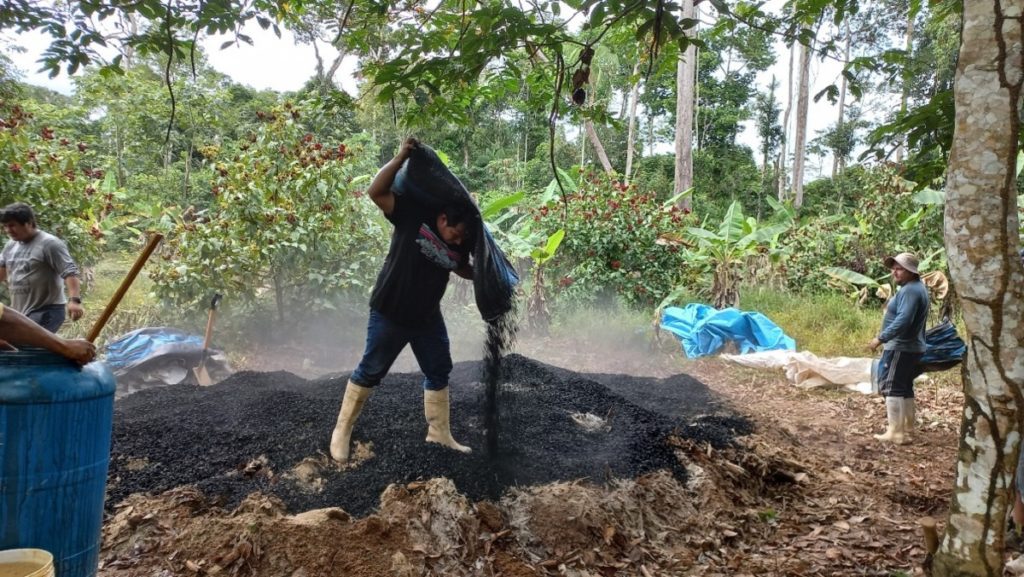
Here’s how the miners made the soil amendment:
- First, topsoil and leaf litter were gathered from the local forest – these materials contain organic components with naturally occurring, beneficial microorganisms necessary for healthy soil. The topsoil and leaf litter were then spread out into a thin layer.
- Next, sacks of marine algae, phosphate rock, and biochar were added to the layer of topsoil and mixed.
- The miners made a second mixture consisting of yeast, molasses, and oxygenated water, which they then poured onto the topsoil mixture.
- All ingredients were mixed until homogenous. The mixture was covered to avoid moisture loss and was left to sit for eight days to encourage growth of the beneficial microorganisms.
- After eight days, the mixture was ready to be applied to the saplings!
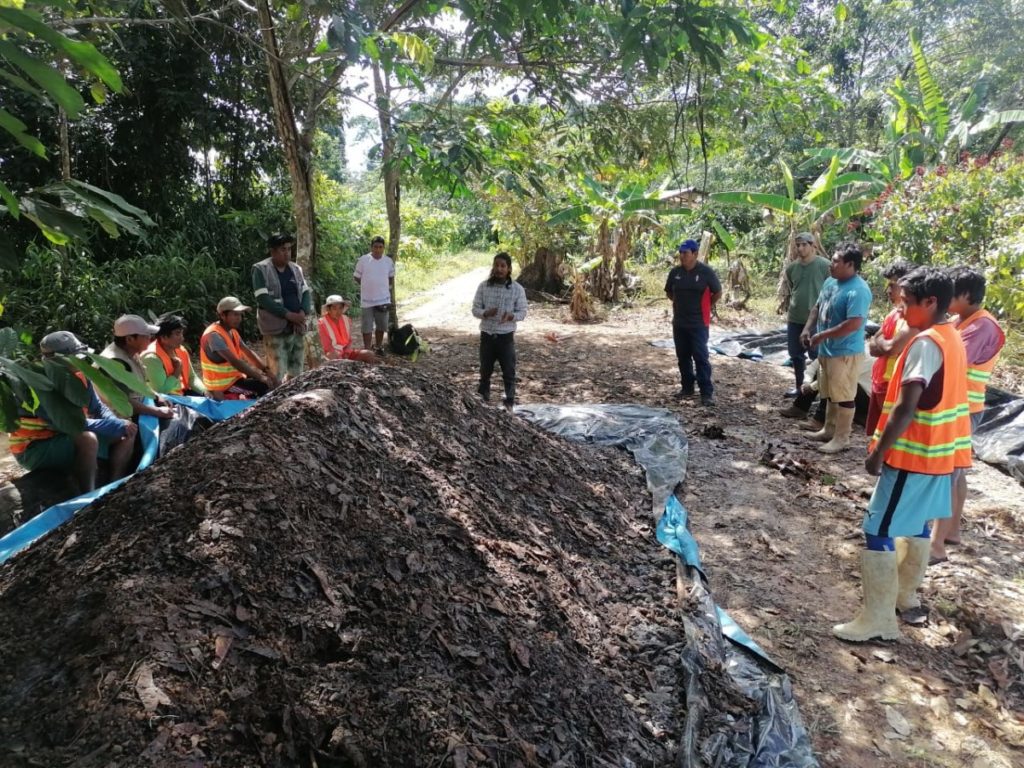
Each tree received a custom-tailored amount of soil amendment depending on size and root system extension. The miners first formed a ring around each of the plants with a pickaxe, taking care not to disturb the root system.
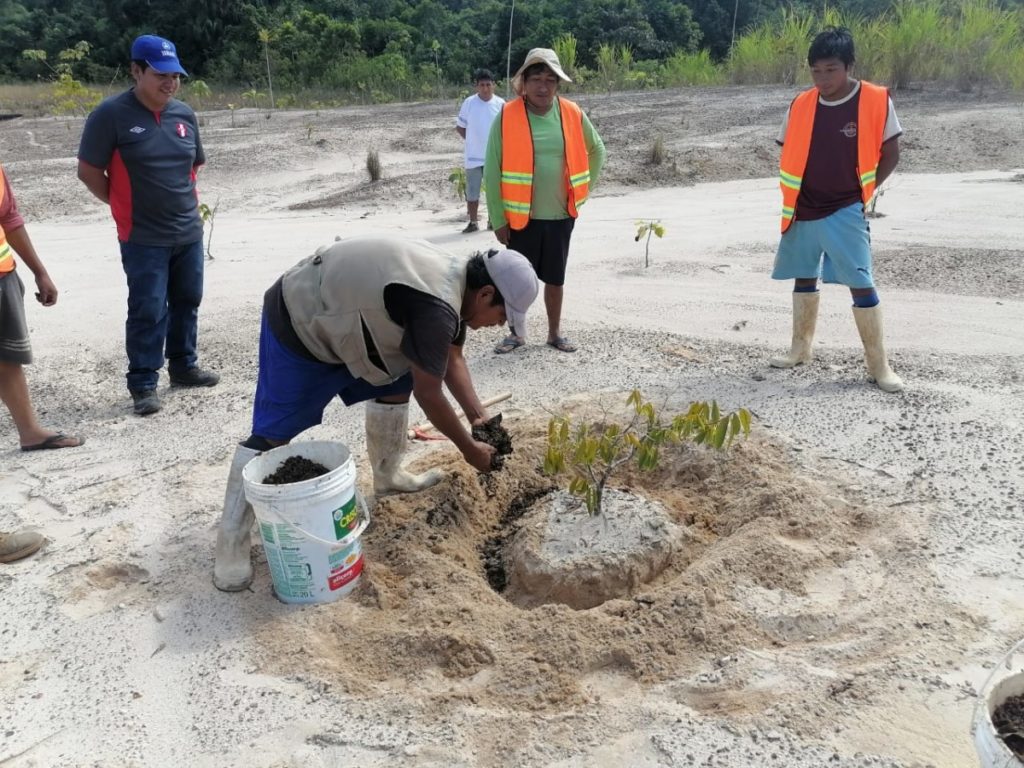
They then applied a layer of soil amendment to the bottom of the ring, then a layer of leaf litter, and then finally a layer of dirt. The addition of leaf litter is to ensure that the moisture from the soil amendment is not lost too quickly through direct contact with the sandy soil.
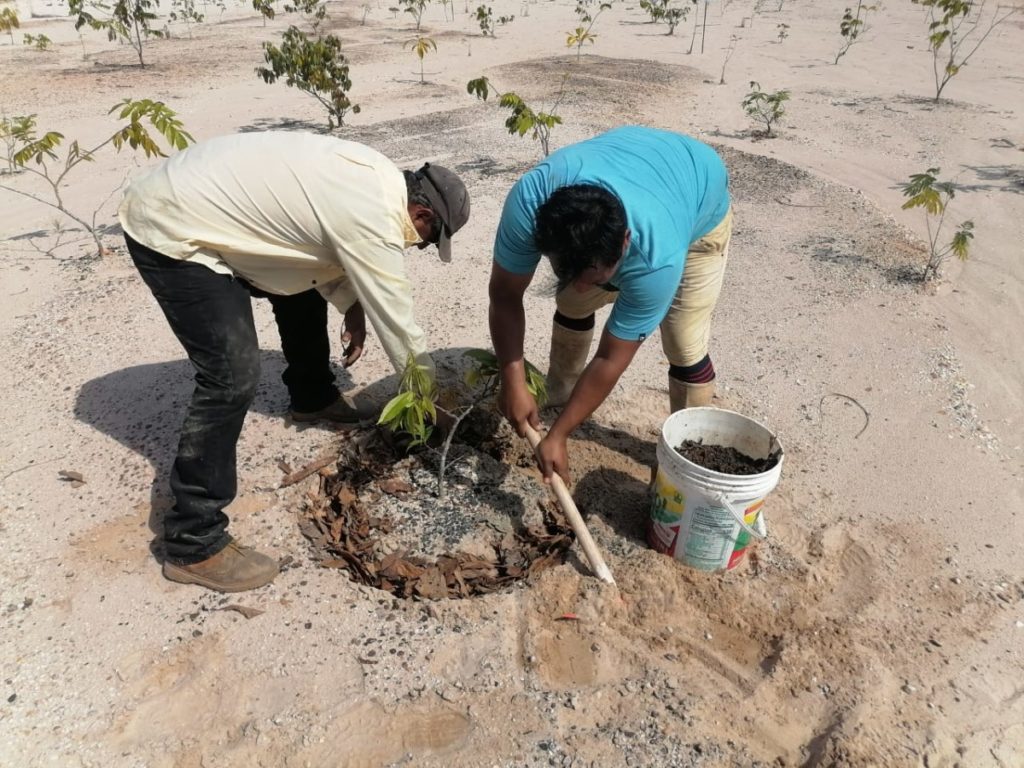
In addition to providing nutrients, soil amendments may help recover soil structure; the texture of the biochar provides micro- and macro-pores important for beneficial microorganisms. Soil amendments can also aid in the retention of water, alleviating erosion and avoiding rapid water depletion.
Madre de Dios has a marked dry period from around April through October every year. Newly planted trees can sometimes struggle to survive this period due to lack of water; improving water retention can boost survivability of the saplings.
Soil improvement is only the first step to assuring a more sustained nutrient enrichment of the planted saplings. Next, Pure Earth plans to supplement these efforts with the use of native cover species, which will help improve soil structure, avoid erosion, and better control the surrounding temperature.
It is important to highlight that, as pioneers in reforesting mined-out Amazonian forest, Pure Earth along with local partners are still investigating the efficacy of soil amendments, cover species, and other methods used to improve degraded Amazonian soil.
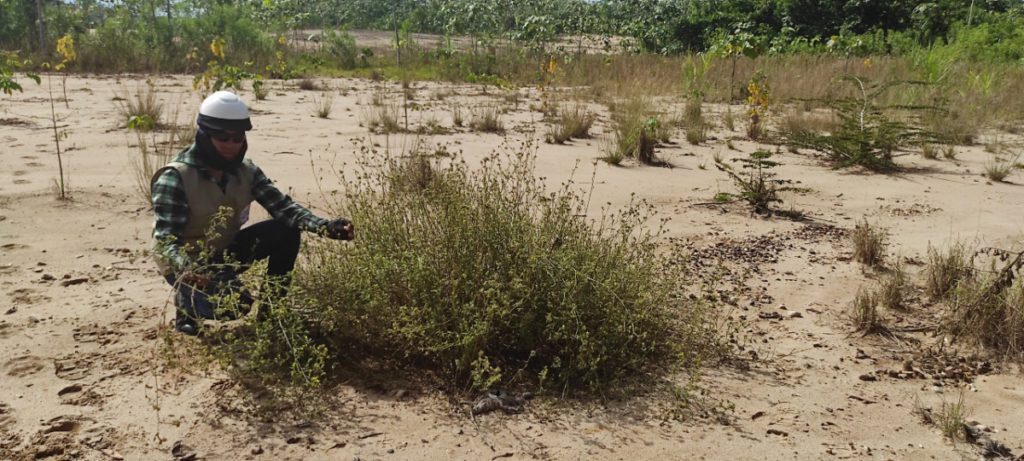
Evaluation Of Mining Ponds
AMATAF miners are also helping in another type of innovative research being done to evaluate mining ponds, which are artificial bodies of water that form after mining with suction pumps. These landscapes slowly begin to form the basis of a habitat for species of fish, reptiles, mammals, and birds that use these areas for food. Because mining ponds form part of the new landscape created post-mining, it is important to consider these areas when planning restoration work.
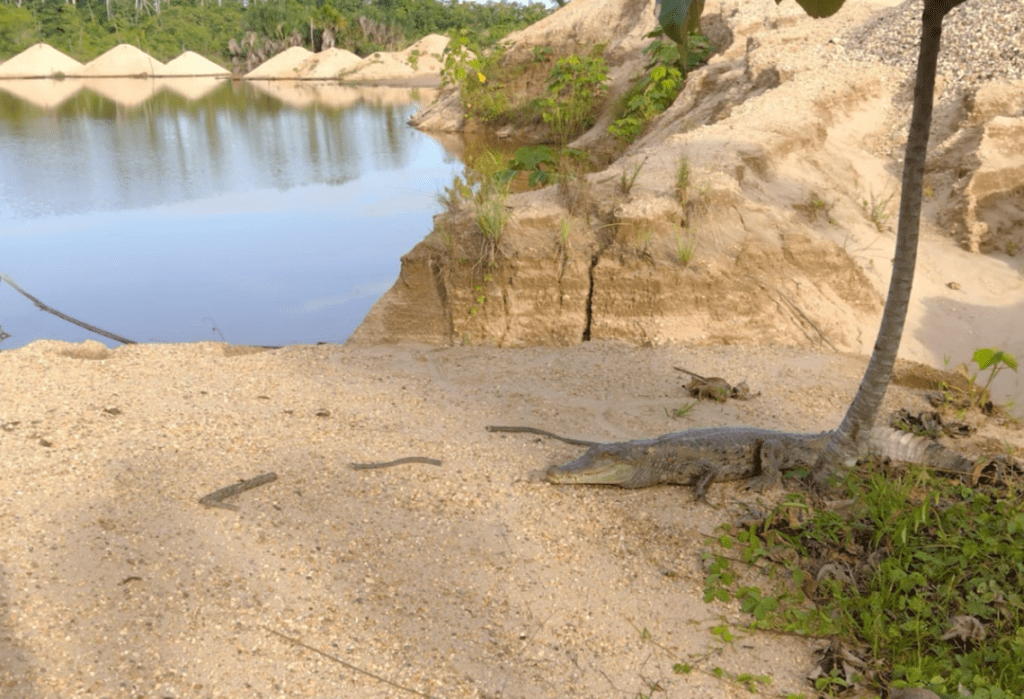
Current laws do not have clear guidelines on how to manage mining ponds. There is also no consensus among the mining sector and relevant ministries. Unlike in the highlands or the coast of Peru, mining ponds in the Amazon region quickly populate with a rather high level of biodiversity. It is therefore important to evaluate their conditions before covering or closing the ponds.

Pure Earth works alongside local institutions to research these mining ponds in AMATAF. In May of this year, university students from the Catholic University of Peru alongside technicians from CINCIA’s hydrobiology program performed scientific evaluations of mining ponds in AMATAF’s mining concession Linda II.
In these research trips, the students and technicians measured and evaluated various physicochemical and hydrobiological parameters of the ponds. This information can be used to generate recommendations for possible uses that these ponds could have post-mining.

AMATAF Miners Are Models For The Future
AMATAF’s future is bright. The association’s miners have learned to make and apply soil amendments, reforested six hectares of land, and embraced mercury-free techniques like the shaking table to process their gold. But they are not stopping there. Thanks to the support of the global jewelry company Brilliant Earth, AMATAF miners, assisted by Pure Earth, will work to restore an additional three hectares of land.
In addition to this important land restoration work, Pure Earth, AMATAF miners, and project partner Alliance for Responsible Mining (ARM) are working hand-in-hand to achieve Fairmined Eco-Certification for four of AMATAF’s mining concessions. Fairmined Eco-Certification is a rigorous process that ensures potential gold buyers of the miners’ commitment to producing gold in a socially and ecologically responsible way. Once certified, the four AMATAF concessions will join an outstanding group of only four other mines in Peru that can boast the Fairmined label.
The sky’s the limit for these motivated miners!
This article is by Caroline Baylor, Pure Earth’s Program Associate for Latin America, and France Cabanillas, with support from Sofia López for Pure Earth.
Pure Earth would like to thank Brilliant Earth Foundation for their grant supporting Green Mining, a project to establish the first mercury-free gold supply chain from the Peruvian Amazon. Pure Earth would like to thank the Tiffany & Co. Foundation for their support of reforestation efforts and training miners in mercury-free techniques.



